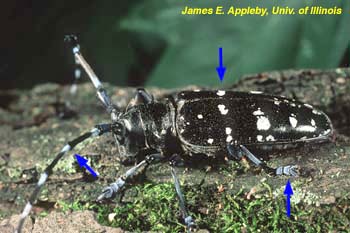
News stories about the Asian longhorned beetle killing maples and
other hardwood trees in New York and Illinois have generated reports and
inquiries about this insect in Florida. Although this insect was recently
intercepted at a warehouse in Ft Lauderdale, we have no other verified
records of its occurrence in our state. The purpose of this pest alert
is to give readers information for distinguishing the Asian beetle from
our native longhorned beetles. Any discovery should be reported quickly
so that an established population can be rapidly delimited and controlled.
Until there is research demonstrating that Florida's environment, biological,
and host conditions are unsatisfactory for population establishment, we
must be on the alert for any occurrence of this tree-killing wood borer.
Background. The Asian longhorned beetle (ALB), Anoplophora glabripennis, is a woodboring beetle indigenous to Japan, Korea, and China. It is regularly intercepted at ports of entry as it emerges from wood used for pallets and packing materials. In 1996 it was discovered infesting and killing trees in Brooklyn and Amityville, New York. Federal and state agencies quickly initiated an aggressive program to locate, remove, and destroy all infested trees with the objective of eradicating the two populations. In 1998, the ALB was discovered in three communities near Chicago and another expensive eradication program is now underway. New regulations limiting the importation of solid wood packing materials from China will hopefully keep out additional introductions of this exotic pest.
Host trees. The infestation in New York was most serious in maples and horsechestnut. Other trees infested and killed in the U.S. include ash, poplar, willow, elm, mulberry, and black locust. Many of the same and closely related species occur in Florida.
Beetle Identification. The large size and distinctive markings of the ALB make it relatively easy to identify (see picture below). Adults are about 1 to 1.25 inches long and, like many beetles in the family Cerambycidae, have antennae that are 1.3 to 2.5 times the length of the body. The ALB is distinguished from similarly shaped beetles by its unique combination of:

Reporting. If you observe a beetle that may be the Asian longhorned beetle, try to collect a specimen in a pill bottle or small jar and take it your local office of the Cooperative Extension Service or Division of Forestry. These offices will contact the Division of Plant Industry, Florida Department of Agriculture & Consumer Services, which has personnel trained to identify, survey, and control plant pests. Prompt reporting will help limit the extent and severity of this undesirable exotic insect.
Additional Information. There are a number of web pages with a variety of information and pictures about this insect in the United States. Here are four that will be especially useful for Floridians wishing to learn more and stay up-to-date on the occurrence of the ALB in the United States:
Last modified 28 April 2005.